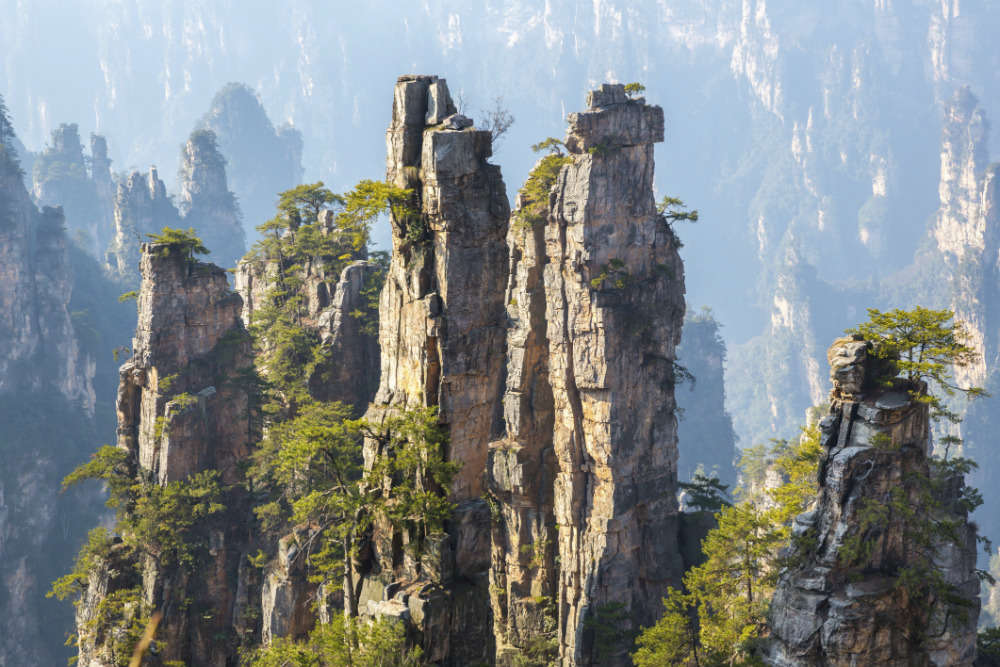
The Formation of Zhangjiajie National Forest Park
Zhangjiajie National Forest Park, located in northwestern Hunan Province, China, is renowned for its towering sandstone pillars that appear to defy gravity. These breathtaking geological formations are the result of a fascinating and lengthy process that has unfolded over millions of years. Let's delve into the captivating story of how Zhangjiajie's iconic landscape came to be.
1. The Birth of Quartz Sandstone: From Volcanic Eruptions to Sedimentary Rock
The story begins approximately 1.5 billion years ago during the Proterozoic Eon, a period marked by significant geological upheaval. The Earth's crust in what is now northwestern Hunan experienced intense tectonic activity. This resulted in the formation of a deep sea trough, a depression in the ocean floor.
Submerged beneath the ancient sea, a volcano erupted, spewing molten lava into the water. This lava, rich in a mineral called quartz, cooled and solidified rapidly upon contact with the seawater. Over time, countless eruptions deposited layer upon layer of quartz-rich volcanic rock on the seabed.
| Geological Period | Event |
|---|---|
| Proterozoic Eon (1.5 billion years ago) | Formation of a sea trough and volcanic eruptions |
Millions of years passed, and the weight of overlying sediments, along with the forces of compaction and cementation, transformed these volcanic deposits into a hard, durable sedimentary rock known as quartz sandstone. This quartz sandstone would serve as the foundation upon which Zhangjiajie's spectacular landforms would eventually rise.
2. The Shaping Hand of Erosion: From Seabed to Sandstone Peaks
Fast forward to approximately 380 million years ago, during the Devonian Period. The region that would become Zhangjiajie underwent a dramatic transformation as tectonic forces uplifted the landmass from the depths of the ocean, exposing the ancient quartz sandstone to the elements.
With the retreat of the sea, the erosive forces of wind, rain, and ice took center stage. The quartz sandstone, though durable, proved no match for the relentless power of nature.
-
Water Erosion: Rainwater, slightly acidic due to dissolved carbon dioxide, seeped into cracks and fissures in the sandstone. Over time, this acidic water dissolved the cementing material that bound the sand grains together, weakening the rock. Flowing water, in the form of rivers and streams, carved valleys and gorges, carrying away eroded sandstone sediment.
-
Wind Erosion: The wind, armed with airborne sand and dust particles, acted like a natural sandblaster, slowly but surely wearing away at the exposed sandstone. This process, known as abrasion, was particularly effective in shaping the peaks, creating sheer cliffs and unusual formations.
-
Freeze-Thaw Weathering: In colder periods, water seeping into cracks would freeze and expand, putting pressure on the surrounding rock. This repeated freezing and thawing, known as frost wedging, caused the cracks to widen and eventually break apart large sections of sandstone.
| Geological Period | Event |
|---|---|
| Devonian Period (380 million years ago) | Uplift of the landmass, exposing sandstone to erosion |
Over millions of years, these erosional forces sculpted the landscape, gradually transforming the once-submerged sandstone plateau into a forest of towering pillars, each with its unique shape and character. The harder, more resistant quartz "eggs" within the sandstone, remnants of the ancient volcanic eruptions, were left standing tall, forming the iconic peaks that have captivated visitors for centuries.
3. Ongoing Evolution: A Landscape in Constant Flux
The story of Zhangjiajie's formation is not a tale confined to the distant past; it is an ongoing process. While the most dramatic transformations occurred over millions of years, the landscape continues to evolve, albeit at a much slower pace.
Even today, the forces of erosion continue to shape and refine the sandstone pillars. Rainfall, wind, and temperature fluctuations continue to slowly wear away at the rock, ensuring that the breathtaking landscape of Zhangjiajie National Forest Park remains a testament to the awe-inspiring power of geological time.
Questions and Answers
Q1: What type of rock forms the iconic pillars of Zhangjiajie? A1: The pillars are composed primarily of quartz sandstone, a sedimentary rock formed from ancient volcanic deposits.
Q2: What role did volcanic activity play in the formation of Zhangjiajie? A2: Volcanic eruptions during the Proterozoic Eon deposited layers of quartz-rich lava, which eventually solidified into quartz sandstone.
Q3: How long did it take for the landscape of Zhangjiajie to form? A3: The process of formation spanned millions of years, beginning with volcanic activity around 1.5 billion years ago and continuing through uplift and erosion to the present day.